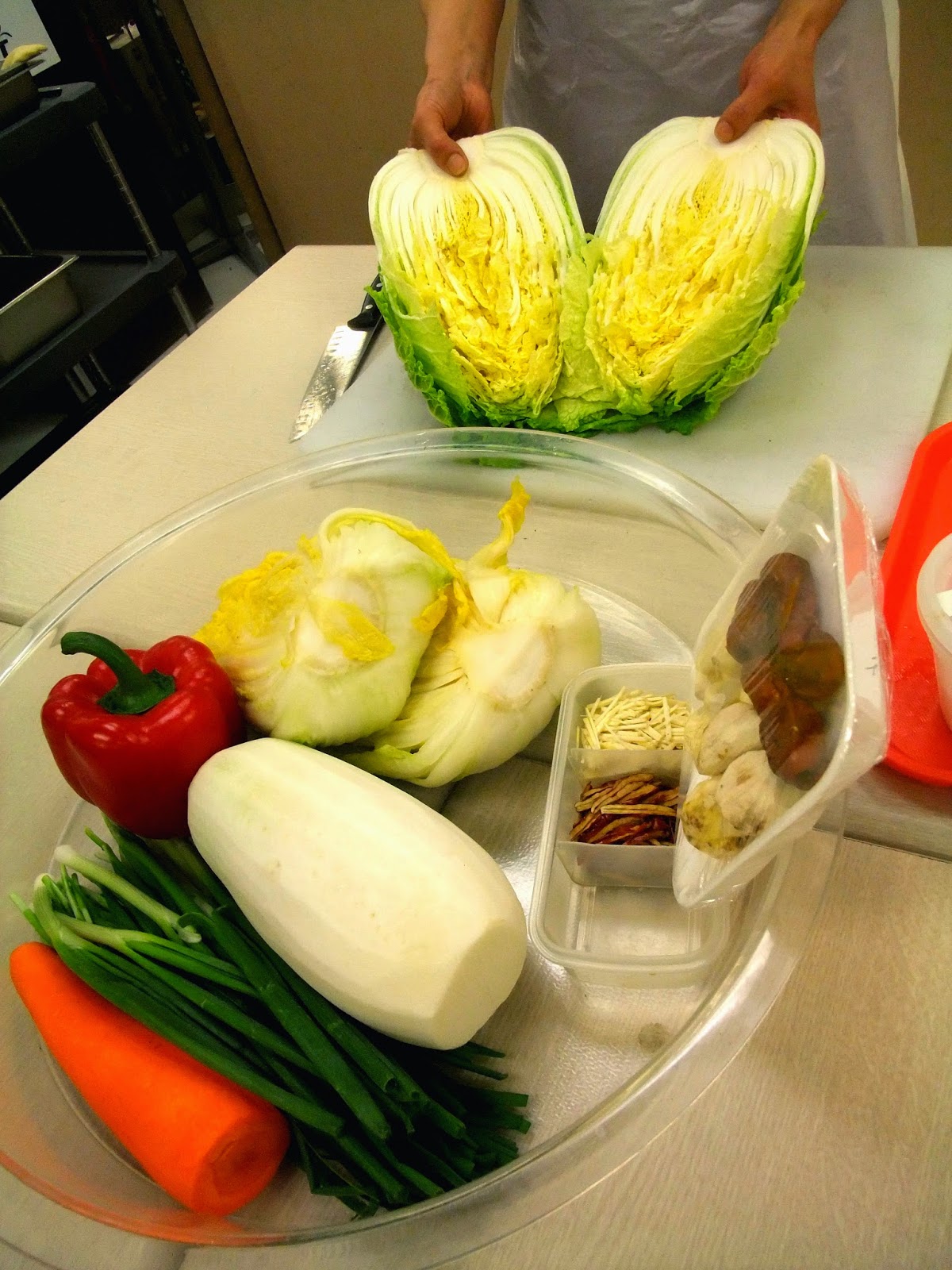I was excited to attend a kimchi making class held at the York Mills location of Toronto's Galleria Korean Supermarket. Note this is mainly a demo class with potential to get hands-on briefly during the process. They were holding it free every other Tuesday starting in January until March, and their cultural class schedule including kimchi-making will change for spring. My family loves kimchi- sour yet sweet, spicy, and savoury with a sparkling carbonated tang and slightly crunchy texture, and it's often served as a side to our Asian meals. According to my most trusted Korean cookbook, Growing Up in a Korean Kitchen- A Cookbook by Hi Soo Shin Hepinstall, Korean kitchens produce more than one hundred kinds of kimchi, using everything from cabbage to watermelon skin and pumpkin blossoms in summer.
Scientific studies indicate that kimchi is incredibly nutritious- a source of protein and vitamins A and B- and is low in calories. It is also a digestive, due to its fibrous texture and lactic acid content. Fermented foods are high on the trending radar this year, along with fermented tea such as kombucha and fermented black garlic as a condiment. The elaborate Korean way of pickling can be made simpler by preserving vegetables in heavily salted water without spices such as soy sauce, fish sauce, fermented red pepper or bean paste. One such pickle is White Cabbage Kimchi (Paek Kimchi). It is made the same as regular whole cabbage kimchi but without the hot red pepper powder, resulting in a pale colour with seasoning toned down providing a more delicate flavour. This kind of kimchi may be a good introduction for the curious to the vast world of kimchi.
Galleria's spread of kimchi offerings from seasoned radish, to the beloved ponytail cabbage kimchi. Pre-salted and drained whole cabbage ready for you to add your own seasoning and spices for a halfway homemade kimchi without the upfront time-consuming preparations.
White Whole Cabbage Kimchi (Paek Kimchi)
3 lb. napa cabbage
1 cup fine salt or table salt
1/4 medium white radish
1 small carrot
3 green onions
8 Asian chives
1/4 red pepper
3 chestnuts
3 ju jube dried dates
1 L cold water and 1 Tbsp. salt
1 Korean pear, minced with juice (use 1/2 cup)
1 onion, minced with juice (use 1/4 cup)
2 cloves garlic, minced
1 1-inch knob ginger, finely grated or minced
First off, cut down only the hard centre stem of whole cabbage, then use your hands to rip open into halves. Teacher says this produces nicer leaves rather than slicing through them and its the traditional preparation method.
Hold cabbage half in a basin and pull down layers of leaves at a time to heavily salt the stems rather than the leaves to help soften and draw out moisture. Do this until you reach the top, and repeat with other cabbage half. Add a cup of cold water to the cabbage halves and let sit for one and a half hours flipping every 20 minutes or so. The stem with be soft and the leaves will be limp. Afterwards, rinse in cold water three times, and let drain completely and dry by facing the cut side down with leaves spread on its sides over two colanders.
Meanwhile, prepare the vegetables that will be placed between the leaves. Thinly slice all your vegetables and place into a large plate or basin for mixing. Peel the chestnuts and pit the dates. Then thinly slice and add to vegetable plate and mix well.
Now we will make the pickling marinade. In a large bowl or container, set a cheesecloth bag in 1L cold water with 1 Tbsp. salt dissolved in it. Place pear, onion, garlic and ginger in the bag and using a gloved hand, press the contents to squeeze the juice into the water with no particulates emitted in the pickling liquid.
Holding one prepared salted and drained cabbage half upright, pull down one layer of leaves at a time and place the mixed vegetables between keeping them concentrated near the stems. Repeat until cabbage is layered and do the same with the other cabbage half.
Wrap your hands tightly around the cabbage bundle, removing the outer cabbage leaf as a belt to bind the cut layer to keep everything intact. Place into a container that would hold two compactly.
Pour the marinating liquid over top to cover 3/4 of cabbage, seal and refrigerate undisturbed for two days.
When ready, cut cabbage in half lengthwise and into three or four pieces to set onto a plate to serve. You can add marinating juice to make it more refreshing, and you can drink it too.
And there you have it, beautiful, delicious, clean white kimchi without all the fiery spices and seasoning!

















Was it a hands-on Kimchi making class for everyone who attended it?
ReplyDeleteI have updated the post to say this was mainly a demo class. There was only a few of us and we took turns to make the kimchi near the end of the process ie; packing the leaves with vegetables. I believe the class is mainly demo and you do not get to take home the results. Hope this helps.
Delete